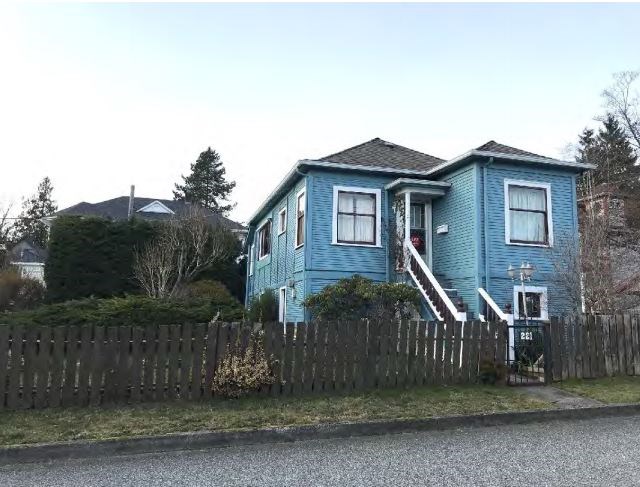Is the protection and restoration of a 1907 home a fair exchange for lot subdivision and construction of a second house on a small lot?
That was the question posed by neighbours during a public hearing held March 22 on a heritage revitalization agreement for 221 Townsend Pl. in the Queen’s Park neighbourhood. The agreement would require the owner to restore the existing home and list it on the city’s heritage register, in exchange for permission to split the lot and build a second home on the property.
City councillors voted 5-2 in favour of the agreement, but not before hearing from numerous speakers – on both sides – at the virtual hearing.
The home in question is a one-storey worker’s cottage, one of eight known examples remaining in New Westminster of the British Columbia Mills Timber and Trading Company’s pre-fabricated wood-frame homes.
“I can’t emphasize the heritage value of this little house enough,” said Elana Zysblat, the heritage professional working on behalf of the homeowner.
She said the prefab homes were considered both “practical and fashionable” and were bought by working-class and white-collar people alike. She told council the Queen’s Park neighbourhood has historically included small lots and modest homes – not just large homes on large lots.
Homeowner Mattia Nichele told councillors he’s not asking for any more density than would, in fact, already be allowed – since existing zoning would allow him to add on to his own home and build a smaller carriage house as well. This way, he said, he’s creating a second family home of similar size (about 1,600 square feet), allowing another family to also own a home in the neighbourhood.
Existing zoning would allow him to cover 35% of the site; the new plan covers 35.2%.
RESIDENT REACTION MIXED
David Brett, a former president of the Queen’s Park Residents’ Association, spoke up in favour of the plan. Brett was involved in the working group that developed the Heritage Conservation Area guidelines for Queen’s Park, and he said this plan is a positive for the neighbourhood.
Having a heritage revitalization agreement would be a win for the home, he said, because nothing in the Heritage Conservation Area imposes any obligation on homeowners to restore their homes – meaning houses can essentially be demolished by neglect.
“These new homeowners, their value system is aligned to restoring their home and pouring a lot of sweat equity into that process,” he said.
Brett said the plan preserves the “single-family character” of the neighbourhood.
Neighbours of the property, however, were less sold. Residents raised concerns about the small size of the two lots that would be created – about 2,360 square feet each – and about the relaxation of setback requirements. They expressed fears the agreement could set a precedent for other properties in the neighbourhood.
Patricia Fraser said neighbours don’t want people to use heritage revitalization agreements as a tool for “unnecessary development.”
“We can’t continue to jam more people into this small area,” she said.
Gail North told councillors Queen’s Park residents aren’t opposed to change but said it’s impossible to get behind an application that “pushes the envelope to bursting.”
She said the lot sizes are too small, the new house has “little to no appeal of design” and the proposal would mean the loss of greenspace.
Sydney McGillis, who also lives on Townsend Place, said she doesn’t understand how the home at 221 Townsend qualifies for a heritage revitalization agreement.
“It is not in jeopardy of being lost; it is not in a state of disrepair,” she said, adding the agreement seems to be more about the housing market than about heritage conservation. “I feel it is a manipulative misuse of the intent of an HRA.”
McGillis said the proposal provides “questionable benefit” to the community but significant benefit to the owner.
“Ask yourself, exactly what is being gained here and who is gaining it?” she said.
Other speakers argued the creation of the second, modest-sized home was a sensible response to the housing crisis.
“I think it represents everything that we should be doing in New Westminster,” said Rick Vugteveen.
COUNCIL VOTE SPLIT
Councillors Chuck Puchmayr and Jaimie McEvoy were the only two council members to vote against the agreement.
Puchmayr said it could well set a precedent and could lead to people promoting properties in the neighbourhood for similar development. He also raised concerns about the loss of green space and trees in the neighbourhood.
McEvoy said the city needs to look closely at how it’s using heritage revitalization agreements, especially given the neighbourhood is already designated as a Heritage Conservation Area.
“If it’s not a vehicle for preserving heritage, it’s not rightly being used,” he said. “I think that’s a pretty valid question: in an HCA, is this really a heritage win?”
McEvoy said that, given the community’s opposition, he would need a compelling reason to vote against the community, and he didn’t see one in this case.
Mayor Jonathan Cote noted the “competing priorities” facing the city.
He acknowledged neighbours’ concerns about densification but said the city needs to look at what the homeowner could already do – in the form of adding a potential suite to the house and a smaller laneway house on the property. He said that, while that approach would add two smaller rental units and might in fact do more for housing affordability, the owner’s proposal also offers an alternative that fits in to the idea of offering more housing options.
Coun. Patrick Johnstone, too, said he was comfortable with the proposal, noting infill housing like this is already part of the Queen’s Park area.
“I don’t think we’re stretching beyond what is reasonable or already established in the neighbourhood,” he said, noting small lots are not common but they’re also not unique. “I think there is a place for this in the community.”
Follow Julie MacLellan on Twitter @juliemaclellan.
Email Julie, [email protected].




